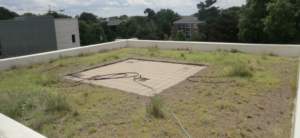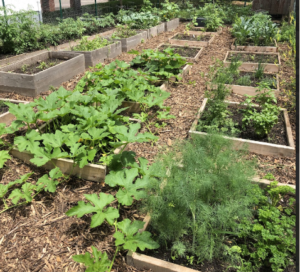Gardens & Landscape
Contact
Sustainability Office1657 Lincoln 651-696-6019
sustainability@macalester.edu
facebook twitter instagram
-
A Pollinator Friendly Campus Macalester has had a long-standing commitment to sustainable, pollinator-friendly landscaping. Some of our efforts include our Landscaping Master Plan, the creation of the Pollinator Path, and hosting a Pollinate Minnesota bee hive at the Ordway Field Station host honey bee hives that are maintained by Pollinate Minnesota.
The Larger Problem
In recent history, honey bees have had increasing difficulty with survival due to lack of habitat, pesticides, and mites. The Rusty Patched Bumblebee, a bee native to the Twin Cities, was added to the endangered species list in 2017. We hope that pollinator friendly initiatives at Macalester can help support this bee by providing safe urban habitat and food sources.
Pollinator Friendly Macalester : A Resolution
As a result of a class project, Emily Sylvestre ’16 with help from the Center for Food Safety, Macalester became the first pollinator-friendly, neonicotinoid-free college in Minnesota in April of 2016. This recognition comes from the BEE Protective Campaign, a program led by Center for Food Safety and Beyond Pesticides.
A resolution was ratified by the College’s student government body and adopted by the VP of Administration and Finance and the Assistant Vice President of Facilities. The signed Pollinator Friendly Resolution commits Macalester to discontinue the use of neonicotinoid pesticides, to plant pollinator-friendly landscaping, and to bolster pollinator education at Macalester and to the broader community.
Progress
As a part of implementing the College’s Landscaping Master Plan, Macalester joins nearly 30 Minnesota municipalities who have signed pollinator friendly resolutions and sets an example for other campus landscape plans.
Macalester is continuously working to increase native pollinator friendly plants across campus.
-
Pollinator Path The Sustainability Office collaborated with staff the University of St. Thomas to create our Pollinator Path. Both colleges are hoping to connect these paths and create an entire Pollinator Path Network, by recognizing pollinator friendly yards throughout the in between neighborhoods and working with other nearby colleges in the future.
The Pollinator Path consists of eight sites – seven of which are located in Saint Paul, while the eighth is in Inver Grove Heights at the Ordway Field Station. Throughout the path we have a printed Pollinator Path Flyer (PDF) to use as your guide as you walk the path.
Path Locations
Take Action
We have complied an extensive list of Pollinator Tips for anyone residing off campus to make their homes pollinator friendly. Some quick tips are:
-
- Buy organic, pesticide-free produce
-
- Plant a diversity of flowers with varied bloom times to provide pollinator food all season long
-
- Do not buy neonicotinoid treated seeds and avoid the use of pesticides
-
- Advocate that your community become pollinator friendly; pledge to increase clean habitat and reduce pesticide use
-
- For further facts about the Rusty Patch Bumblebee and actions you can take to ensure their survival, see the US Fish and Wildlife Service’s Website
Additional Resources
-
- More information about Neonicotinoids
-
- Pollinate Minnesota an education and advocacy organization working toward a better Minnesota for Pollinators and people founded by Erin Rupp ’04
- Learn more about the pollinators on campus! Pollinators on campus include honey bees and bumblebees, but also wasps, syrphid flies, butterflies and moths and beetles. Other animals, such as birds, bats, rodents, etc. also pollinate plants.
-
-
Landscape & Turf Macalester has replaced several turf areas with native plants, increasing both the amount of precipitation that can be absorbed as well as the biodiversity of the area. This choice also reduces the amount of water used and greenhouse gas emissions associated with maintaining the area. Also, plant basins were installed at the edges of some parking lots. Filled with a specially engineered sand that filters out harmful phosphorus from the rainwater, the water is then used by the plants and trees in the basin rather than running off into the stormwater system.
The Macalester Grounds Department has made some sustainable landscaping choices, such as maintaining sharp lawnmower blades and mowing at a higher height, which improves soil health and in turn allows the soil to absorb more precipitation. Also, in 2021, the department upgraded the irrigation controls to a new system that optimizes the amount of water used through a combination of soil moisture sensors and online weather data.
-
Green Roofs 
A History of The Green Roofs:
The green roof on the fishbowl was completed on April 14, 2006. It was led by the MacCARES green roof task force made up on Alese Colehour ’09 and Ellie Rogers ’09 in association with Green Roof Blocks, Aloha Landscaping, Rosenquist Construction, and Facilities Management. The green roof on Kagin was completed in 2007 by students Alese Colehour, Timothy Den Herder-Thomas, Angelina Lopez, and Ellen Rogers, with faculty advisement from Dr. Jerald Dosch and Dr. Dan Hornbach.
What is a Green Roof?
A green roof places a healthy, living garden on top of an urban or commercial rooftop allowing for several environmental, economic, and aesthetic improvements. Green roofs can help in the following areas:
- Reducing and filtering stormwater runoff
- Improving air quality through carbon sequestration
- Absorbing heat in summer and insulating in winter
- Mitigating urban heat island effect
- Doubling, or even tripling, a roof’s lifespan
- Creating habitat for wildlife
- Reducing noise pollution
-
Mulch Garden New Content Coming Soon!
